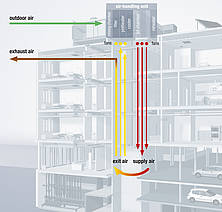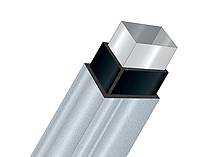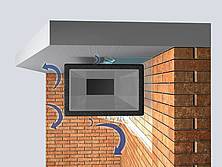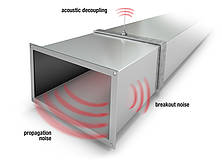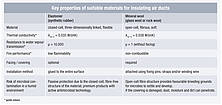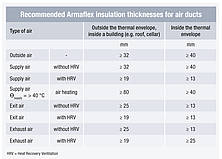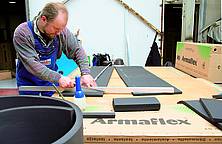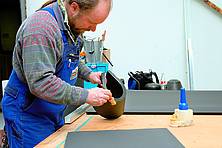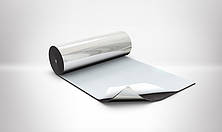Münster, 30 November 2012 – There are many different requirements for insulation materials for air ducts: the ductwork must be protected against energy losses and condensation when the temperature falls below the dew point. At the same time, the insulation should provide noise control by reducing the breakout noise from installations. In order to ensure a healthy indoor climate, it is important that the insulation is easy to clean and that dust and bacteria cannot settle on it. In addition to the technical demands which the materials must fulfil, there are also requirements concerning the ease of installation. It must be possible to install the materials used easily and reliably even under difficult conditions on the building site.
Ventilation and air-conditioning technology is still on the rise: today not only public, commercial and industrial buildings, such as hospitals, schools, office buildings, hotels, shopping centres and production facilities, but also single- and multi-family homes are equipped with HVAC systems which supply air to and extract it from working, living and technical rooms.
The key task of ventilation and air-conditioning systems is to provide a comfortable indoor climate and thus promote people’s physical and mental well-being.
Depending on the specific requirements, the system should:
- clean the air through controlled exchange,
- humidify or dehumidify the air and
- heat and/or cool the air.
As a rule ventilation and air-conditioning systems consist of one or several air handling units (AHUs), ventilation lines (air ducts) to transport the air and duct vents, through which air is supplied to and extracted from the rooms of the building. Fans are usually built into the air ducts at certain intervals to transport the air.
In general, the following distinctions are made between the air ducts:
- outdoor air ducts: fresh air which is carried into the building from outdoors;
- supply air ducts: air which is brought into the room and heated, cooled and humidified as required;
- exit air ducts: ‘used’ air which is extracted from the room;
- exhaust air ducts: ‘used’ air which is discharged from the building.
Figure 1 shows the various sections into which the air ducts are divided.
Why do air ducts need to be insulated?
The treated air should be distributed throughout the building in an energy-saving manner with as little heat or cold loss as possible. If temperatures on the outer or inner surface of the air duct drop below the dew point, the air handling units, especially the outdoor air and exhaust air ducts, must also be protected against condensation. If condensation forms on the insulation it can lead to considerable costs; not only must the damage be repaired, follow-up costs can also arise from water damage to ceilings, for example. In addition, breakout noise from installations should be reduced and the ducts should be acoustically decoupled.
Which materials should be used to insulate air ducts depends on the function of the duct (outdoor, supply, exit or exhaust air duct), its location inside or outside the building and the difference in tem-perature between the air in the duct and that in the direct surroundings. In general, the entire surface of outdoor, supply and exit air ducts should be thermally insulated along the whole length of the duct. Exhaust air ducts should also be insulated – in buildings to provide noise control and outside buildings to prevent condensation.
In Europe, insulation is usually installed on the outer surface of the air duct. However, there are also applications in which the insulation materials are applied to the inside of the duct. When air ducts are insulated on the inside, it is essential to bear in mind that the insulation materials used must be suit-able for this purpose and not represent any health risk. Whereas installing insulation on the inside of air ducts is the preferred method in the USA, it is seldom used in Continental Europe. In many coun-tries, building regulations restrict the installation of combustible materials inside the duct.
Air ducts are typically made of sheet steel and consist of relatively short sections which are connected by duct flanges. It is at these flanges that the ducts are usually attached to the building structure leaving a certain clearance. Therefore, when selecting the insulation material, it is also important to consider whether the material can be installed effectively on the duct flanges and ensure that the duct is acoustically decoupled from the building structure at the mounting points.
Air ducts may be either rectangular or round. Their dimensions vary greatly, ranging from ducts with a height of approx. 10 to 15 cm, which are used above suspended ceilings, for example, to the outdoor air ducts of large ventilation systems which are several metres high and wide.
Suitable materials for insulating air ducts
The range of insulation materials which are suitable for use on air ducts is limited. Because the longer individual parts of the air ducts are usually specially shaped on their surfaces in the so-called ‘envelope pattern’ to achieve linear reinforcement of the duct segment, only products may be used which can be fitted to the shaped surface of the duct segments and also to elbows and other rounded installations. This means that the insulation must be either soft or flexible. This requirement restricts the choice of insulation materials to mineral wool (MW) and synthetic rubber (FEF – flexible elastomeric foam). Table 1 gives a comparison of the key properties of these materials which are decisive for use on air ducts.
Although in Germany the Muster-Lüftungsanlagen-Richtlinie (MLüAR 2005 - fire protection require-ments for air ducts) demands that non-combustible materials are used on air ducts, materials of the buildings materials class “low flammability” are permitted.
The great advantage of insulation materials made of synthetic rubber is that they consist of a closed-cell, homogenous, highly flexible material with a smooth surface. The closed-cell structure ensures high ‘built-in’ resistance to both water vapour transmission and absorption of moisture from the ambi-ent air or, in the case of outdoor installations, rain water. The homogenous, three-dimensionally linked structure ensures that the insulation thickness, thermal and other properties of the insulation are maintained in the long term. It also prevents the air being contaminated with particles of insulation material, fibres, dust, microbes or other elements which can contribute to air pollution. Due to its high flexibility, the material can be installed neatly. The flexible insulation material can be used well even on complexly-shaped installations and under difficult conditions on the building site. The smooth surface of the elastomeric material with its closed-cell structure can be kept dust-free and clean and is a much less favourable environment for microbes than open-cell and fibrous mineral wool.
Indoors, elastomeric insulation materials made of synthetic rubber can be installed on air ducts without additional coatings or coverings.
For applications in which laminated insulation materials are required for reasons of appearance or cleaning purposes, elastomeric insulation materials with aluminium facing are a suitable choice. These insulation sheets, such as ArmaFlex Duct made by Armacell, are equipped with an aluminium facing, which is relatively thin but reinforced with a mineral fibre web. Provided there is no increased risk of the faced surface being damaged by mechanical impact in the course of maintenance work, these products certainly offer benefits. They can be installed quickly and easily, meet aesthetic demands due to the attractive silver finish and are easy to clean.
For outdoor applications, e.g. for insulating outdoor and exhaust air ducts on the roofs of buildings, UV-resistant materials must be installed. Here factory pre-covered products such as Arma-Chek Silver are highly suitable. The insulated installations can be covered in applications which require a surface which is extremely resistant to mechanical impact, because the ducts run though highly frequented areas, for example. Here metal jackets are usually used.
Air duct insulation for condensation control
In general, all air ducts should be insulated: to provide noise control, to save energy and, where necessary, to prevent condensation. Condensation control is always required when the temperature in the room through which the duct runs is higher than that of the cooled air in the duct. Condensation also occurs when warm air is transported through cooler rooms in summer, for example. If they are not insulated, condensation forms on the inner surface of the air duct. The intensity of the condensation process depends on the difference in temperature (surroundings and air duct) and the humidity of the ambient air. When humidity is high, even a slight different between the temperatures can lead to condensation. At a humidity of 90 % even a temperature difference of 2 K is sufficient for condensation to form constantly on the surface of an uninsulated air duct. Therefore, it is important not to calculate the insulation thickness on the basis of the average, but the highest possible relative humidity of the ambient air – even if this very high humidity only occurs on a few days in the year. When selecting the insulation material and calculating the insulation thickness, the aim should be to achieve an insulation which is reliable and secure in the long term.
Influence of the surface coefficient of heat transfer on the insulation thickness
When calculating the insulation thickness, not only the humidity, but also the surface coefficient of heat transfer must be considered. The surface coefficient of heat transfer describes the intensity of heat transfer on the surface of the duct for a certain difference in temperature between the ambient air and the outer surface of the air duct. If the surface coefficient of heat transfer drops while the other conditions (ambient air temperature, relative humidity and air temperature in the duct) remain the same, the temperature on the outer surface also falls to counterbalance the intensity of the heat transfer. If the surface coefficient of heat transfer is not taken into account correctly when calculating the insulation thickness, there is a risk of the temperature of the outer surface lying below the dew point and condensation forming.
Why does the surface coefficient of heat transfer fall compared to usual conditions? On the one hand, this can occur if the thermal insulation is covered with a metal jacket made of zinc, aluminium or stainless steel sheeting, for example. A metal jacket has higher thermal radiation than the usual black elastomeric insulation and the surface coefficient of heat transfer for a metal surface is almost 50 % lower than for insulation without a jacket. This means that the minimum insulation thickness must be almost twice as high to reliably prevent condensation under these conditions.
The surface coefficient of heat transfer is also reduced if air ducts are installed too closely to each other or to building elements. Therefore, when planning and installing ventilation and air-conditioning systems, it is essential to ensure that pipes and ducts are not laid too closely to each other or with insufficient clearance to walls and other fixtures. Apart from the fact that it is difficult to install insulation properly if this is the case, there is also the danger of build-up zones being created. In these areas, the air circulation (convection) needed for a sufficiently high surface temperature is stopped, i.e. in such build-up zones the surface coefficient of heat transfer is lower (Figure 3). As a result, the risk of condensation increases considerably.
Therefore, under DIN 4140, ‘Insulation work on industrial installations and building service equipment’, a clearance of 100 mm is required between the insulated pipes and from the pipes to the wall or ceil-ing. For vessels, fittings etc. a clearance of at least 1000 mm should be provided. In the case of building service equipment, however, practice shows that the clearances required by DIN 4140 cannot be allowed with for the majority of installations due to a lack of space. In order to be on the safe side, the contractor should inform the client in writing beforehand and reach an agreement with him, if deviations from DIN 4140 are planned.
Condensation can not only form on the outer surface, but also on the inside of the air duct if the duct transports warm, moist air through rooms with lower temperatures. To avoid this, the duct can be insulated on the inside or outside.
An advantage of using elastomeric insulation materials inside air ducts is that they are highly resistant to wear. Even air speeds of up to 10 m/s cause no whatsoever damage to the material. However, if installation is installed inside air ducts, the client should be warned that there may initially be a characteristic rubber smell.
As insulating air ducts on the inside is only possible to a limited extent in many European countries, condensation inside the ducts is usually prevented by professional insulation of the outer surface.
If the insulation is intended to prevent condensation, closed-cell insulation materials with a high resis-tance to water vapour transmission should be used. Elastomeric insulation materials with their built-in diffusion barrier provide much greater security than open-cell insulation materials where the barrier is limited to a thin aluminium foil, which is easily damaged during the building work.
Recommended insulation thicknesses for air ducts
In general, all air ducts inside and outside buildings should be thermally insulated. When determining the insulation thicknesses to be used, the following factors should be taken into account:
- temperature of the air in the duct,
- temperature of the ambient air,
- humidity of the ambient air (and, in certain circumstances, of the air in the duct too),
- covering of the duct,
- length of the duct and its dimensions (height and width),
- whether the duct is intended only for ventilation or also for cooling / heating the room, and
- potential build-up zones.
Concrete calculations of the insulation thicknesses must also consider the thermal conductivity of the insulation material used, of course. Table 3 gives guide values for recommended insulation thick-nesses which depend on the installation circumstances, the function of the duct and whether the duct is used for heat recovery.
Higher energy savings with optimized insulation thicknesses
Compared to an uninsulated duct, a lot of energy can be saved through insulation. Greater insulation thicknesses allow this energy saving to be further increased. In order to identify the potential savings achieved through a thicker insulation layer, Armacell has done a model calculation. The object of the investigation is a typical 100 metre-long air duct network (ducts measuring 700 mm by 500 mm) which supplies a building with slightly cooled air. 13 mm was taken as the minimum insulation thickness and this, of course, already provides certain energy savings. By using a thicker insulation layer the energy saving potential can be increased to almost 9000 kWh of thermal energy in the course of a cooling season. The greater insulation thickness has the effect that the cooled air in the duct only warms very slowly which in turn means that the cooling system needs to be operated less frequently. In the repre-sentative case study, over € 500 can be saved per cooling season by increasing the insulation thick-ness.
Ducts which carry air at temperatures above room temperature, i.e. which heat the rooms of a build-ing, must be insulated with wall thicknesses of at least 40 mm and if they run outside the buildings (although this is hardly ever the case) with 80 mm.
From an energy perspective, it is essential that the ducts are airtight. When operating ventilation sys-tems, it is not the systems for heating or cooling the air which have the highest energy consumption. The lion’s share of the energy used is accounted for by the operation of the fans. In general, energy is needed to compensate for the flow resistance and thus the drop in pressure, but much higher energy losses occur at points where the air ducts are not tight. These points constitute a pure loss as the air which leaks from the air duct here is forfeited and not supplied to the supply point. Installing closed-cell elastomeric insulation sheets on the air ducts can also save energy in this respect: due to their high density they can seal leaks and thus at least reduce losses.
Acoustic aspects of air duct insulation
Air ducts provide buildings with fresh, heated or cooled air, thus ensuring a pleasant room climate. However, ductwork can also have the unwanted side-effect of carrying noise around buildings – this may be from fans or other mechanical systems, airflow noise and also voices from neighbouring rooms. This distracting ambient noise not only makes it difficult to concentrate, it can also be a health hazard. Therefore, when planning and installing duct insulation not only thermal, but also acoustic requirements should be taken into account.
At the planning stage, one must bear in mind that noise from air ducts arises and is transmitted in different ways. Only a combination of sound absorption and barrier, vibration damping and decoupling ensures that noise transfer is largely prevented. In addition to the air-borne noise from the duct outlets, sound may also transmit directly through the wall of the ducting and into the surrounding room. This breakout noise can be dampened by insulating the outside of the ducts with a viscoelastic material. Further attenuation is achievable when an additional mass layer is applied as a covering onto the insulation.
Structure-borne noise arises due to the mounts (duct hangers or supports) attaching the ductwork to walls or ceilings and travels through the building in the form of vibrations. To prevent this, special flexible fittings should be used which acoustically isolate the duct system from the structural elements of the building.
Elastomeric insulation materials have relatively good noise absorption properties in the low frequency range. The viscoelastic material reduces breakout noise, decouples the air duct from the structural elements and thus reduces the transmission of structure-borne noise into the building. Using the ArmaFix duct support prevents (thermal and) acoustic bridges occurring at the mounts. In addition, with its ArmaSound products Armacell provides acoustic insulation materials with exceptionally good sound absorption properties across a broad frequency range.
Installing elastomeric insulation materials on air ducts
Important factors when selecting insulation materials are not only the technical properties, but also the methods with which these materials are installed and secured on the air ducts. The installation of elastomeric insulation sheets is simple, but still requires sound knowledge of the material and an understanding of how to glue the insulation material reliably. It is essential that the insulation sheets are glued correctly and functionally to the entire surface of the air duct and at all butt joins. A great advantage of elastomeric insulation materials is that they can be installed easily and neatly without the need for any special tools or an electricity supply on the building site. The sheets are simply glued to the cleaned surface of the duct, no further measures (such as the use of fixing pins) are required. When installed correctly, the elastomeric insulation sheets form a smooth, continuous surface without any openings, protruding rivets or similar obstacles which could easily damage the surface of the insulation during maintenance work. As an additional measure, the glued butt joins of the elastomeric insulation can be secured with a suitable self-adhesive tape. Detailed installation instructions can be found in the application guides which leading manufacturers of elastomeric insulation materials provide.
The homogenous, three-dimensionally linked structure of the elastomeric insulation material allows the sheets to be cut cleanly without the emission of dust or fibrous particles which could be breathed in and thus represent a health hazard. The high flexibility of the material means that it can be fitted easily, even on complexly shaped installations. Here little loss or waste occurs which is an environ-mental advantage. By using self-adhesive sheets - which are increasingly being installed on air ducts – adhesive consumption and therefore the emission of volatile organic compounds (VOCs) can be drastically reduced.
Summary
Elastomeric insulation sheets provide an effective, reliable, clean and healthy choice for the thermal and acoustic insulation of air ducts. They not only reduce energy losses in the operation of ventilation and air-conditioning systems, correctly calculated insulation thicknesses also reliably prevent conden-sation. However, insulation thicknesses should not only be designed to prevent condensation but also to ensure optimal energy savings. Against the backdrop of rising energy prices, spending money on greater insulation thicknesses is a sound investment in the future.
Apart from their good thermal properties, elastomeric insulation materials also meet the requirements for noise control. They reduce breakout noise, decouple the air duct from the structural elements and thus reduce the transmission of structure-borne noise into the building.
The dust- and fibre-free materials also have passive protection against micro-organisms. It is much more difficult for microbes to settle on the smooth, non-porous surface of the elastomeric material than in open-cell mineral fibre products and they do not find the nutrients they need to grow. Above and beyond this, products which are equipped with antimicrobially-active additives, such as the AF/- and SH/ArmaFlex range made by Armacell, provide active protection against bacteria and fungal growth. These additives penetrate the cell walls of the microbes and disable important cell functions. As a result the micro-organism is unable to function and can no longer grow or multiply. The technology ensures that the growth of the microbes is continuously inhibited and thus provides the insulation materials with permanent protection against bacteria and mould. Because the insulation is equipped with this protection at the manufacturing stage, it cannot wash or wear off. Elastomeric products with Microban® technology are particularly suitable for use in public buildings, health care facilities, schools, nurseries, but also in process industries such as the food and beverage or pharmaceutical industries.
Due to climatic changes and rising standards in terms of living and working comfort, the International Energy Agency (IEA) expects a rapidly growing demand for air-conditioning in Europe. It estimates that the energy requirements for air-conditioning will grow approximately twice as fast as the overall energy requirements of buildings. In some buildings, air-conditioning already accounts for around half of the overall electricity consumption. In order to operate air-conditioning and ventilation systems as energy-efficiently as possible, it is important to insulate the installations properly using suitable materials.

